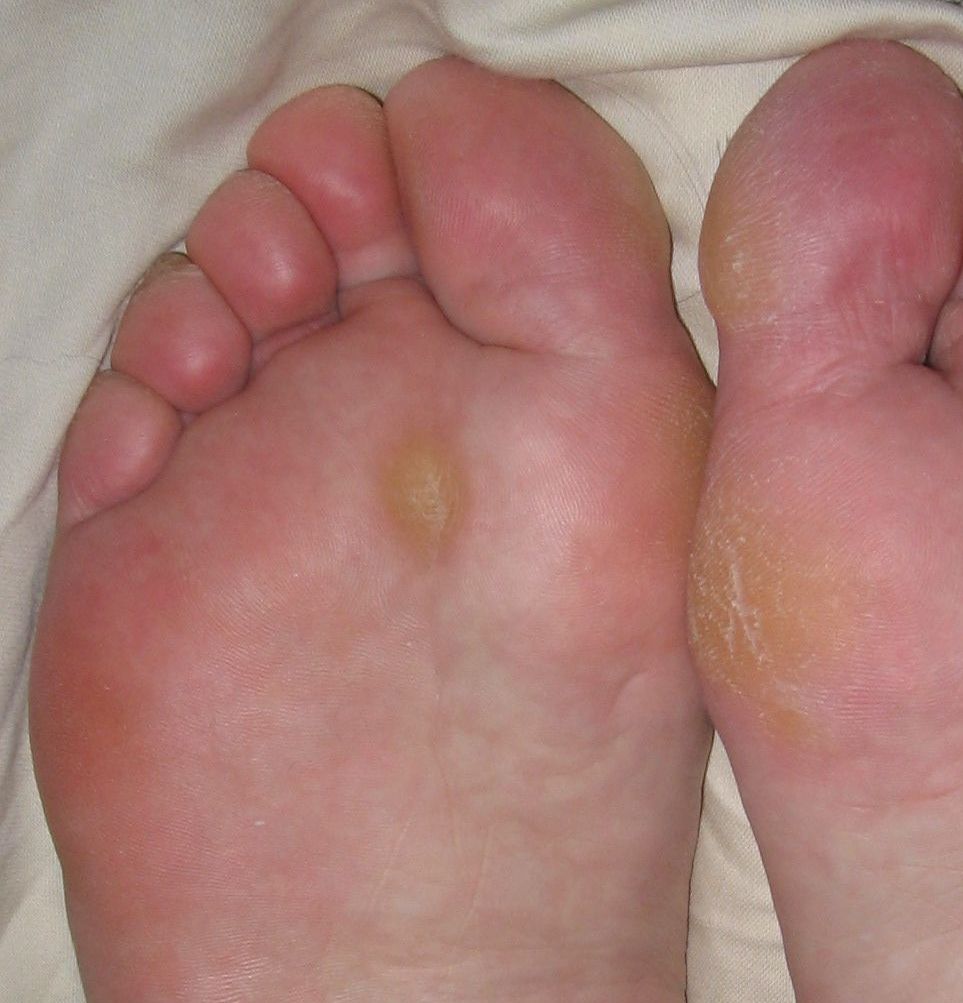Corns, Calluses: Symptoms, Causes & Treatment
What are the symptoms of calluses and corns?
Calluses and corns are thickened areas of skin that develop in response to repeated pressure, friction, or irritation. They typically occur on the feet, hands, or other areas of the body that are subject to repetitive stress. While calluses and corns are similar in nature, they differ in their appearance and location:
- Calluses:
- Calluses are larger, flat areas of thickened skin that are typically painless.
- They often develop on the palms of the hands, soles of the feet, or other areas that are subjected to repeated pressure or friction.
- Calluses may have a yellowish or gray color and can feel dry and rough to the touch.
- Corns:
- Corns are smaller, round areas of thickened skin that have a central core of hardened tissue.
- They often develop on the tops or sides of the toes, or on the bottom of the feet.
- Corns can be painful, especially when pressure is applied to them, such as when wearing tight shoes.
Common symptoms of calluses and corns include:
- Thickened, hardened skin
- Rough, dry, or flaky skin
- Discomfort or pain when pressure is applied to the affected area
- A raised bump or circular area of skin in the case of corns
- Redness or inflammation around the affected area
- Occasionally, fluid-filled sacs (blisters) may form over the callus or corn
Calluses and corns are typically harmless and can often be treated at home. However, if they are causing significant discomfort or if you have diabetes or other conditions that affect circulation, it’s important to seek medical advice before attempting to treat them yourself. A healthcare provider can recommend appropriate treatment options and help prevent complications.
What are the causes of calluses and corns?
Calluses and corns develop in response to repeated pressure, friction, or irritation on the skin. The primary causes of calluses and corns include:
- Ill-fitting Footwear: Shoes that are too tight, too loose, or have high heels can create pressure points on the feet, leading to the formation of calluses and corns.
- High Heels: Wearing high-heeled shoes can increase pressure on the balls of the feet and toes, leading to the formation of corns.
- Foot Deformities: Conditions such as bunions, hammertoes, or bone spurs can alter the alignment of the foot and create pressure points that lead to calluses and corns.
- Repetitive Motion: Activities or occupations that involve repetitive motion or pressure on the hands or feet can lead to the formation of calluses.
- Playing Musical Instruments: People who play musical instruments such as stringed instruments or drums may develop calluses on their fingers or hands from repeated contact with the instrument.
- Manual Labor: People who perform manual labor or activities that involve gripping tools or equipment may develop calluses on their hands.
- Walking Barefoot: Walking barefoot, especially on hard surfaces like pavement or concrete, can increase the risk of developing calluses and corns.
- Abnormal Walking Patterns: Conditions that alter the way you walk, such as flat feet or high arches, can create pressure points on the feet that lead to calluses and corns.
- Age: As people age, the skin becomes thinner and less elastic, making it more susceptible to damage and the formation of calluses and corns.
- Poor Foot Hygiene: Not keeping the feet clean and dry can contribute to the development of calluses and corns.
It’s important to note that while calluses and corns are typically harmless, they can be painful and may require treatment if they cause discomfort or if they are located in areas that are prone to infection. Proper footwear, regular foot care, and addressing underlying foot issues can help prevent the formation of calluses and corns.
What are the treatments for calluses and corns?
The treatment for calluses and corns aims to reduce the thickened skin and relieve any pain or discomfort associated with them. Treatment options may include:
- Proper Footwear: Wearing properly fitting shoes with a wide toe box can help reduce pressure on the feet and prevent calluses and corns from forming or worsening.
- Padding: Using protective pads or cushions can help reduce friction and pressure on the affected area.
- Moisturizers: Applying moisturizing creams or lotions to the affected area can help soften the skin and reduce the thickness of calluses and corns.
- Pumice Stone or File: Gently rubbing the affected area with a pumice stone or file can help remove dead skin and reduce the size of calluses and corns.
- Salicylic Acid: Over-the-counter products containing salicylic acid can help soften the skin and reduce the size of calluses and corns. Follow the product instructions carefully.
- Orthotic Devices: Custom orthotic devices or inserts can help redistribute pressure on the feet and reduce the risk of developing calluses and corns.
- Avoiding Barefoot Walking: Minimizing walking barefoot, especially on hard surfaces, can help prevent calluses and corns from forming.
- Trimming: If necessary, a healthcare provider can trim or remove thickened skin using a scalpel or other instruments. It is not recommended to attempt this at home, as it can lead to infection or other complications.
- Foot Soaks: Soaking the feet in warm water can help soften the skin and make it easier to remove dead skin. Adding Epsom salts or essential oils to the water can enhance the effects.
- Medical Treatment: In some cases, a healthcare provider may recommend medical treatment, such as prescription-strength salicylic acid, corticosteroid injections, or surgical removal of the callus or corn.
It’s important to consult with a healthcare provider before attempting to treat calluses and corns, especially if they are causing pain or discomfort. A healthcare provider can provide guidance on the best treatment approach based on the severity of the condition and individual factors.




